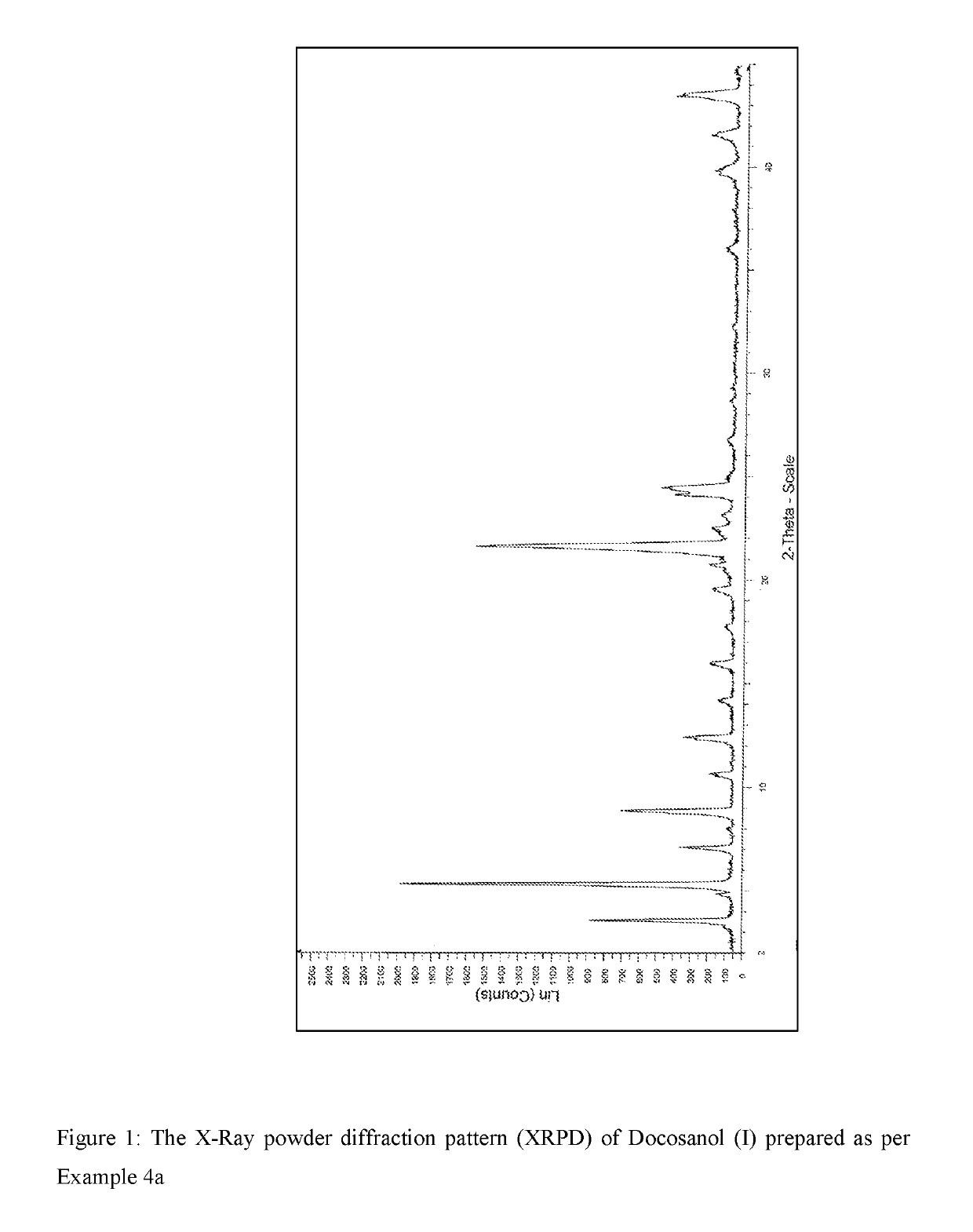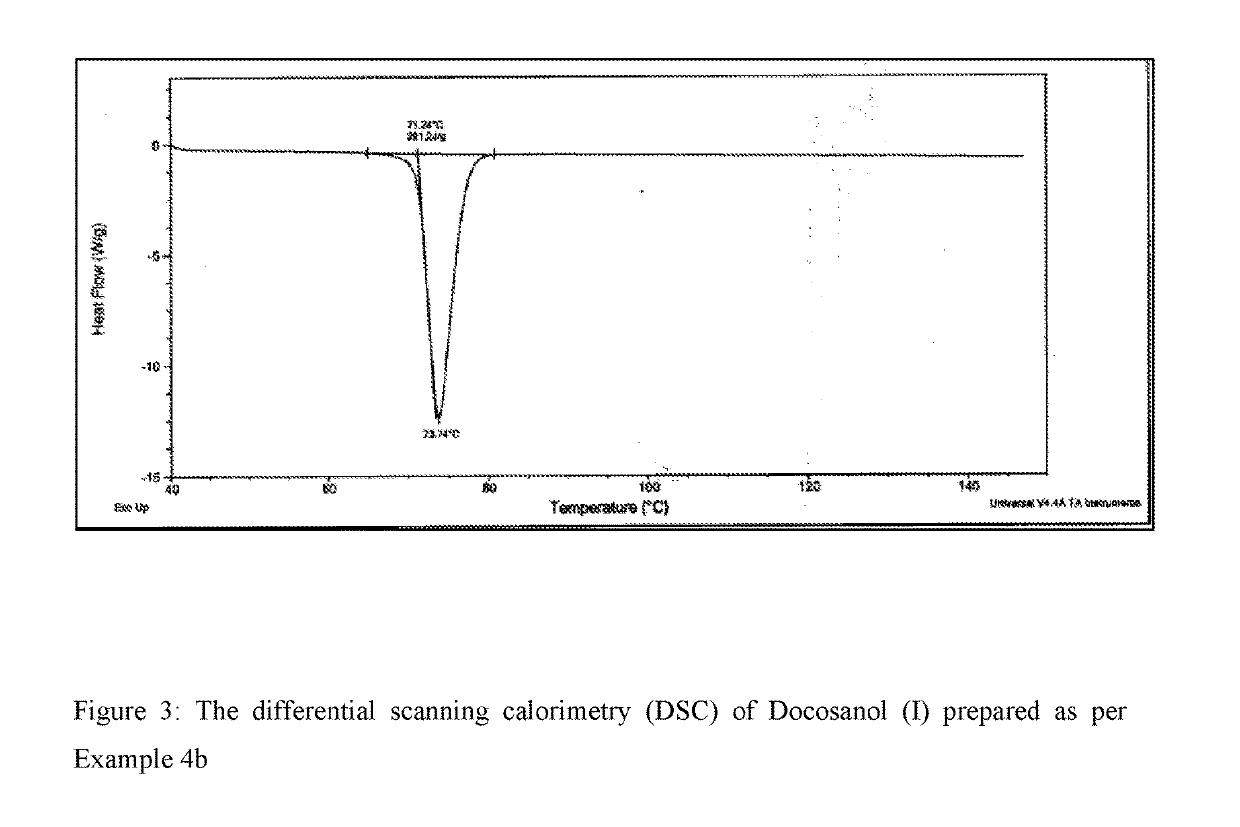Novel Process for the Synthesis of Docosanol
a technology of docosanol and process, applied in the field of new process for the synthesis of docosanol, can solve the problems of limiting the use of these processes in large-scale, low yield of desired components,
- Summary
- Abstract
- Description
- Claims
- Application Information
AI Technical Summary
Benefits of technology
Problems solved by technology
Method used
Image
Examples
example-1
Preparation of Icosanal (III)
[0109]100 g (0.335 moles) of 1-eicosonol (IV) and dichloromethane were added to a round bottom flask at 25-30° C. and temperature was raised to 35-40° C. to get the clear solution. The reaction mass was cooled to 25-30° C. and 0.47 g (0.003 moles) of (2,2,6,6-tetramethylpiperidin-1-yl)oxyl (TEMPO) was added. A mixture of 9-12% aqueous sodium hypochlorite and sodium bicarbonate solution (8%) were then added for 1-2 hours to maintain pH between 8.5 to 9.5. After completion of reaction, 40% aqueous sodium thiosulphate pentahydrate solution was added to the reaction mixture and stirred for 5 minutes at 25-30° C. The reaction mass was then extracted with dichloromethane and distilled off under reduced pressure till 6 volumes of dichloromethane remains. The intermediate Icosanal (III) so obtained can be immediately used in the next step.
[0110]Purity %: 80.0
example-2
Preparation of (E)-ethyl docos-2-enoate (II)
[0111]In a clean and dry round bottom flask, intermediate Icosanal (III) dissolved in dichloromethane as obtained in the Example-1 and 140 g of ethyl 2-(triphenylphosphoranylidene) acetate were added at 25-30° C. and the reaction mixture was heated for 4-5 hours at 45-50° C. After completion of reaction, the dichloromethane solvent was distilled off under vacuum and the crude so formed was washed with cyclohexane. The crude so obtained was cooled to 25-30° C., 400 mL of cyclohexane was added and stirred for 30 minutes. Filtered the reaction mixture under vacuum to remove the precipitated solid and washed with cyclohexane. To the filtrate 140 mL of methanol was added and stirred for 30 minutes at 25-30° C. To this 60 mL water was added and layers were separated. The organic layer was distilled off under vacuum to yield viscous liquid (E)-ethyl docos-2-enoate (II).
[0112]Yield %: 77-81; Purity %: 92.0.
example-3
Preparation of Crude Docosanol (I)
[0113]In a clean and dry round bottom flask, 100 g of the (E)-ethyl docos-2-enoate (II) was dissolved in 1000 mL of tetrahydrofuran and 200 mL methanol at 25-30° C., then cooled to 10-15° C. 41 g of sodium borohydride was added portion wise for 1-2 hours. The reaction mass was stirred for 1 hour at 25-30° C. and maintained for 20-24 hours at 60-65° C. After completion of reaction, the reaction mass was cooled to 25-30° C. and slowly the above reaction mass was added to 1000 mL of water at 15-20° C. The pH of the reaction was adjusted to 1.0-2.0 using concentrated hydrochloric acid and temperature was raised to 25-30° C. The organic solvent was removed under reduced pressure below 50° C. till 11-12 volumes of reaction mass remains. The reaction mass was cooled to 30-35° C. and extracted with dichloromethane. The total organic layer was collected and washed with water then the solvent was distilled off under vacuum to obtain crude Docosanol (I).
[0114]...
PUM
| Property | Measurement | Unit |
|---|---|---|
| temperature | aaaaa | aaaaa |
| temperature | aaaaa | aaaaa |
| temperature | aaaaa | aaaaa |
Abstract
Description
Claims
Application Information
 Login to View More
Login to View More - R&D
- Intellectual Property
- Life Sciences
- Materials
- Tech Scout
- Unparalleled Data Quality
- Higher Quality Content
- 60% Fewer Hallucinations
Browse by: Latest US Patents, China's latest patents, Technical Efficacy Thesaurus, Application Domain, Technology Topic, Popular Technical Reports.
© 2025 PatSnap. All rights reserved.Legal|Privacy policy|Modern Slavery Act Transparency Statement|Sitemap|About US| Contact US: help@patsnap.com



